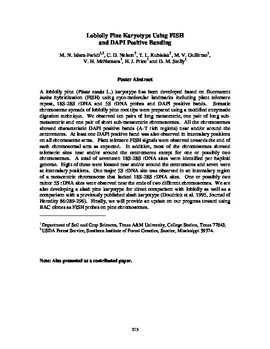| dc.contributor.author | Islam-Faridi, M. N. | |
| dc.contributor.author | Nelson, C. D. | |
| dc.contributor.author | Kubisiak, T. L. | |
| dc.contributor.author | Gullirmo, M. V. | |
| dc.contributor.author | McNamara, V. H. | |
| dc.contributor.author | Price, H. J. | |
| dc.contributor.author | Stelly, D. M. | |
| dc.date.accessioned | 2016-04-25T19:36:08Z | |
| dc.date.available | 2016-04-25T19:36:08Z | |
| dc.date.issued | 2003 | |
| dc.identifier | oksd_sf27_p213.pdf | |
| dc.identifier.citation | Islam-Faridi, M. N., Nelson, C. D., Kubisiak, T. L., Gullirmo, M. V., McNamara, V. H., Price, H. J., & Stelly, D. M. (2003). "Loblolly Pine Karyotype Using FISH and DAPI Positive Banding." In 27th Southern Forest Tree Improvement Conference, Stillwater, OK | |
| dc.identifier.uri | https://hdl.handle.net/11244/33704 | |
| dc.description.abstract | A loblolly pine (Pinus taeda L.) karyotype has been developed based on fluorescent insitu hybridization (FISH) using cyto-molecular landmarks including plant telomere repeat, 18S-28S rDNA and 5S rDNA probes and DAPI positive bands. Somatic chromosome spreads of loblolly pine root tips were prepared using a modified enzymatic digestion technique. We observed ten pairs of long metacentric, one pair of long submetacentric and one pair of short sub-metacentric chromosomes. All the chromosomes showed characteristic DAPI positive bands (A-T rich regions) near and/or around the centromeres. At least one DAPI positive band was also observed in intercalary positions on all chromosome arms. Plant telomere FISH signals were observed towards the end of each chromosomal arm as expected. In addition, most of the chromosomes showed telomeric sites near and/or around the centromeres except for one or possibly two chromosomes. A total of seventeen 18S-28S rDNA sites were identified per haploid genome. Eight of these were located near and/or around the centromeres and seven were at intercalary positions. One major 5S rDNA site was observed in an intercalary region of a metacentric chromosome that lacked 18S-28S rDNA sites. One or possibly two minor 5S rDNA sites were observed near the ends of two different chromosomes. We are also developing a slash pine karyotype for direct comparison with loblolly as well as a comparison with a previously published slash karyotype (Doudrick et al. 1995, Journal of Heredity 86:289-296). Finally, we will provide an update on our progress toward using BAC clones as FISH probes on pine chromosomes. | |
| dc.format | application/pdf | |
| dc.language | en_US | |
| dc.relation.ispartofseries | Sponsored publication . . . of the Southern Forest Tree Improvement Committee ; no. 49 | |
| dc.rights | This paper is made available through open access and the auspices of the fair use doctrine for scholarly, educational and research purposes while recognizing the publisher already offers a free online version. The OSU Library�s intent is to offer access and preserve publications involving its faculty contributions. Contact the Digital Resources and Discovery Services at lib-dls@okstate.edu or 405-744-9161 for the permission policy on the use, reproduction or distribution of this material. | |
| dc.source | Proceedings of the 27th Southern Forest Tree Improvement Conference, volume 27, 2003. Editor, Craig R. McKinley. | |
| dc.title | Loblolly Pine Karyotype Using FISH and DAPI Positive Banding | |
| dc.type | text | |
| osu.filename | oksd_sf27_p213.pdf | |
| dc.type.genre | Conference proceedings | |
| dc.description.scopeandcontents | Papers and abstracts from the 27th Southern Forest Tree Improvement Conference held at Oklahoma State University in Stillwater, Oklahoma on June 24-27, 2003. | |
